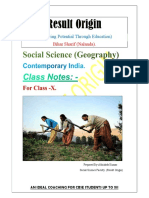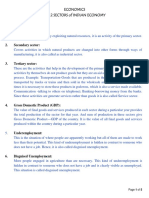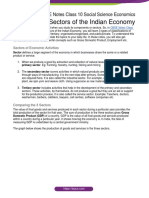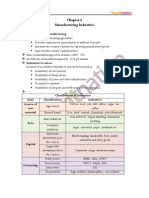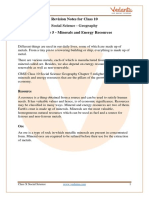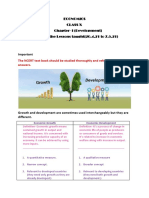CBSE Class 10 Social Science Revision Notes Geography Chapter-1 Resources and Development
Uploaded by
Aadi GautamCBSE Class 10 Social Science Revision Notes Geography Chapter-1 Resources and Development
Uploaded by
Aadi GautamCBSE
Class 10 Social Science
Revision Notes
Geography Chapter-1
Resources and Development
1. Resource: Everything available in our environment which can be used to satisfy our
needs, provided, it is technologically accessible, economically feasible and culturally
acceptable can be termed as ‘Resource’.
2. TYPES OF RESOURCES : These resources can be classified in the following ways –
(a) On the basis of origin – biotic and abiotic
(b) On the basis of exhaustibility – renewable and non-renewable
(c) On the basis of ownership – individual, community, national and international
(d) On the basis of status of development – potential, developed stock and reserves.
Biotic Resources obtained from biosphere and have life such as human beings, flora
and fauna, fisheries, livestock etc.
All those things which are composed of non-living things are called abiotic resources.
For example, rocks and metals.
Renewable Resources can be renewed or reproduced by physical, chemical or
mechanical processes For example, solar and wind energy, water, forests and wildlife,
etc.
Non-Renewable Resources occur over a very long geological time. Minerals and fossil
fuels are examples of such resources. These resources take millions of years in their
formation.
Individual Resources are owned privately by individuals. Example: Many farmers
own land which is allotted to them by government against the payment of revenue.
Community Owned Resources are resources which are accessible to all the members
of the community. Example: Village commons (grazing grounds, burial grounds,
village ponds, etc.) public parks, picnic spots,playgrounds in urban areas etc.
National Resources Technically, all the resources belong to the nation. The country
Material downloaded from myCBSEguide.com. 1 / 5
has legal powers to acquire even private property for public good.
International Resources are international institutions which regulate some resources.
The oceanic resources beyond 200 km of the Exclusive Economic Zone belong to open
ocean and no individual country can utilise these without the concurrence of
international institutions.
Potential Resources: Resources which are found in a region, but have not been
utilised. For example, the western parts of India particularly Rajasthan and Gujarat
have enormous potential for the development of wind and solar energy, but so far
these have not been developed properly.
Developed Resources Resources which are surveyed and their quality and quantity
have been determined for utilisation.
3. DEVELOPMENT OF RESOURCES
Resources are vital for human survival as well as for maintaining the quality of life. It was
believed that resources are free gifts of nature. Human beings used them indiscriminately
and this has led to the following major problems:
Depletion of resources for satisfying the greed of few individuals.
Accumulation of resources in few hands, which, in turn, divided the society into two
segments i.e. haves and have nots or rich and poor.
Indiscriminate exploitation of resources has led to global ecological crises such as,
global warming, ozone layer depletion, environmental pollution and land
degradation.
Material downloaded from myCBSEguide.com. 2 / 5
4. Resource Planning in India : It involves :
identification and inventory of resources across the regions of the country. This
involves surveying, mapping and qualitative and quantitative estimation and
measurement of the resources.
Evolving a planning structure endowed with appropriate technology, skill and
institutional set up for implementing resource development plans.
Matching the resource development plans with overall national development plans.
5. Conservation of Resources:
Resource conservation at various levels is important.
Gandhiji was very apt in voicing his concern about resource conservation in these
words: “There is enough for everybody’s need and not for any body’s greed.”
6. LAND UTILISATION
Land resources are used for the following
purposes:
Forests
Land not available for cultivation
(a) Barren and waste land
(b) Land put to non-agricultural uses, e.g. buildings, roads, factories, etc.
Other uncultivated land (excluding fallow land)
(a) Permanent pastures and grazing land,
(b) Land under miscellaneous tree crops groves (not included in net sown area),
Material downloaded from myCBSEguide.com. 3 / 5
(c) Cultruable waste land (left uncultivated for more than 5 agricultural years).
Fallow lands
(a) Current fallow-(left without cultivation for one or less than one agricultural year),
(b) Other than current fallow-(left uncultivated for the past 1 to 5 agricultural years).
Net sown area
Area sown more than once in an agricultural year plus net sown area is known as gross
cropped area.
7. Land use Pattern in India :
Total geographical area of India is 3.28 million sq. km.
Land use data however is available only for 93% of the total area because the land use
reporting far most of the North-East States except Assam has not been done fully.
Some area of Jammu and Kashmir occupied by Pakistan and China have also not been
surveyed.
The land under permanent pasture has also decreased.
Material downloaded from myCBSEguide.com. 4 / 5
Fallow land - left without cultivation far one or less than one agricultural year.
Net sown area total -total area sown in an agricultural year.
More net sown area in Punjab and Haryana.
Less net sown area in Arunachal Pradesh, Mizoram, Manipur and Andaman
Nicobar Islands.
National Forest Policy in India in 1952.
Waste land includes rocky, Arid and desert area and land put to other non
agricultural uses includes settlements, roads, railways, industry etc.
Continuous use of land over a long period of time without taking appropriate
measures to conserve and manage it.
8. LAND DEGRADATION AND CONSERVATION MEASURES
At present, there are about 130 million hectares of degraded land in India.
Some human activities such as deforestation, over grazing, mining and quarrying too
have contributed significantly in land degradation.
In states like Jharkhand, Chhattisgarh, Madhya Pradesh and Orissa deforestation due
to mining have caused severe land degradation.
In states like Gujarat, Rajasthan, Madhya Pradesh and Maharashtra overgrazing is
one of the main reasons for land degradation.
In the states of Punjab, Haryana, western Uttar Pradesh, over irrigation is responsible
for land degradation.
Material downloaded from myCBSEguide.com. 5 / 5
You might also like
- Swage (D) Nipples and Bull Plugs: MSS SP-95-2018No ratings yetSwage (D) Nipples and Bull Plugs: MSS SP-95-201822 pages
- Principles of Textile Testing by Je Booth 0592063259 PDF20% (5)Principles of Textile Testing by Je Booth 0592063259 PDF5 pages
- Classification of Resources: Notes Class 10 Chapter 1 - Resources and Development GeographyNo ratings yetClassification of Resources: Notes Class 10 Chapter 1 - Resources and Development Geography18 pages
- Cbse Chapter 2 Federalism Class 10 Notes PDFNo ratings yetCbse Chapter 2 Federalism Class 10 Notes PDF7 pages
- Forest and Wildlife Resources 2023 24 Notes - 230615 - 120218No ratings yetForest and Wildlife Resources 2023 24 Notes - 230615 - 12021827 pages
- Class 10Th - Geography - Chapter 1 - Resources and Development100% (2)Class 10Th - Geography - Chapter 1 - Resources and Development42 pages
- Chapter 2 - Forest and Wildlife Resources: CBSE Notes Class 10 Social Science GeographyNo ratings yetChapter 2 - Forest and Wildlife Resources: CBSE Notes Class 10 Social Science Geography3 pages
- Class X Subject: Social Science Economics CH 1 Development NotesNo ratings yetClass X Subject: Social Science Economics CH 1 Development Notes10 pages
- NCERT Solutions Class 10 Social Science - Geography Chapter 1: Resources and DevelopmentNo ratings yetNCERT Solutions Class 10 Social Science - Geography Chapter 1: Resources and Development8 pages
- Forest and Wildlife Resources Class 6 Next Topper SST100% (1)Forest and Wildlife Resources Class 6 Next Topper SST16 pages
- Natural Vegetation and Wildlife Notes PDFNo ratings yetNatural Vegetation and Wildlife Notes PDF8 pages
- Class Notes - Development BY SHUBHAM PATHAK MA'AMNo ratings yetClass Notes - Development BY SHUBHAM PATHAK MA'AM5 pages
- NCERT Solutions Class 10 Social Science Geography Chapter 2 Forest and Wildlife ResourcesNo ratings yetNCERT Solutions Class 10 Social Science Geography Chapter 2 Forest and Wildlife Resources4 pages
- Economics CH: 2 Sectors of Indian Economy: GlossaryNo ratings yetEconomics CH: 2 Sectors of Indian Economy: Glossary5 pages
- Extra Questions for Class 9 Geography Chapter 5 Natural Vegetation and WildlifeNo ratings yetExtra Questions for Class 9 Geography Chapter 5 Natural Vegetation and Wildlife29 pages
- Cbse Class 10 Social Science Political Science Chapter 7 NotesNo ratings yetCbse Class 10 Social Science Political Science Chapter 7 Notes3 pages
- CBSE Notes Class 10 Social Science Economics Chapter 2 Sectors of The Indian EconomyNo ratings yetCBSE Notes Class 10 Social Science Economics Chapter 2 Sectors of The Indian Economy5 pages
- Cbse Class 10 Social Science Geography Chapter 5 NotesNo ratings yetCbse Class 10 Social Science Geography Chapter 5 Notes10 pages
- Economics Class X Chapter-I (Development) Gist of The Lessons Taught (20.4.21 To 7.5.21)No ratings yetEconomics Class X Chapter-I (Development) Gist of The Lessons Taught (20.4.21 To 7.5.21)6 pages
- Forest and Wildlife Resources: Class 10th - Geography Full Chapter Explanation100% (1)Forest and Wildlife Resources: Class 10th - Geography Full Chapter Explanation47 pages
- The Rise of Nationalism in Europe (10th)No ratings yetThe Rise of Nationalism in Europe (10th)23 pages
- Class 10 Economics Chapter 3 Questions and Answers Money and CreditNo ratings yetClass 10 Economics Chapter 3 Questions and Answers Money and Credit11 pages
- Chapter 7 - Lifelines of National Economy: CBSE Notes Class 10 Social Science GeographyNo ratings yetChapter 7 - Lifelines of National Economy: CBSE Notes Class 10 Social Science Geography4 pages
- MCQ Questions For Class 10 Social Science Forest and Wildlife Resources With AnswersNo ratings yetMCQ Questions For Class 10 Social Science Forest and Wildlife Resources With Answers15 pages
- CH-1 - India - Size - and - Location (1) CLASS 9100% (1)CH-1 - India - Size - and - Location (1) CLASS 921 pages
- CBSE Class 10 History Chapter 5 Notes - Print Culture and The Modern World PDFNo ratings yetCBSE Class 10 History Chapter 5 Notes - Print Culture and The Modern World PDF7 pages
- Power Sharing Padhai Ak Mazza Notes 2024No ratings yetPower Sharing Padhai Ak Mazza Notes 20247 pages
- Resources AND Development: Class X (Geography)No ratings yetResources AND Development: Class X (Geography)22 pages
- Water Resources Class 10 Learn With MadhuNo ratings yetWater Resources Class 10 Learn With Madhu42 pages
- Resource and Development: Chapter: 1 (Geography)No ratings yetResource and Development: Chapter: 1 (Geography)13 pages
- Topic: Nationalism in India: Submitted by Submitted To0% (1)Topic: Nationalism in India: Submitted by Submitted To56 pages
- Population Class 9 Notes CBSE Geography Chapter 6 PDFNo ratings yetPopulation Class 9 Notes CBSE Geography Chapter 6 PDF7 pages
- G2 - FOREST AND WILDLIFE RESOURCES - NotesNo ratings yetG2 - FOREST AND WILDLIFE RESOURCES - Notes5 pages
- Sectors of Indian Economy 1658497364976No ratings yetSectors of Indian Economy 165849736497638 pages
- Forest and Wildlife Resources - Exam PackNo ratings yetForest and Wildlife Resources - Exam Pack21 pages
- Firewater Pump Systems For FPSOs and FSOs BROCHURE100% (1)Firewater Pump Systems For FPSOs and FSOs BROCHURE8 pages
- Plant Production Management System For PFAL (Plant Factory With Artificial Lighting) Beijing, China May 9-10, 2015 Association For Vertical FarmingNo ratings yetPlant Production Management System For PFAL (Plant Factory With Artificial Lighting) Beijing, China May 9-10, 2015 Association For Vertical Farming34 pages
- MSTD - BillingSoftware - User Manual Ver 1.01No ratings yetMSTD - BillingSoftware - User Manual Ver 1.0152 pages
- Dkg-175 Automatic Transfer Switch (Without DC Supply)No ratings yetDkg-175 Automatic Transfer Switch (Without DC Supply)11 pages
- Root and Install CWM On Samsung Galaxy Note 8No ratings yetRoot and Install CWM On Samsung Galaxy Note 83 pages
- Typical Velocities Piping Design Chemical Engineering Robert KernNo ratings yetTypical Velocities Piping Design Chemical Engineering Robert Kern1 page
- Maintenance and User'S Manual: Pensky Martens Flash Point TesterNo ratings yetMaintenance and User'S Manual: Pensky Martens Flash Point Tester54 pages
- F&AE - 5SemiAutomaticand AutomaticWeldingNo ratings yetF&AE - 5SemiAutomaticand AutomaticWelding8 pages
- Volume Booster: YT-300 / YT-310 / YT-305 / YT-315 / YT-320No ratings yetVolume Booster: YT-300 / YT-310 / YT-305 / YT-315 / YT-3201 page
- Principles of Textile Testing by Je Booth 0592063259 PDFPrinciples of Textile Testing by Je Booth 0592063259 PDF
- Classification of Resources: Notes Class 10 Chapter 1 - Resources and Development GeographyClassification of Resources: Notes Class 10 Chapter 1 - Resources and Development Geography
- Forest and Wildlife Resources 2023 24 Notes - 230615 - 120218Forest and Wildlife Resources 2023 24 Notes - 230615 - 120218
- Class 10Th - Geography - Chapter 1 - Resources and DevelopmentClass 10Th - Geography - Chapter 1 - Resources and Development
- Chapter 2 - Forest and Wildlife Resources: CBSE Notes Class 10 Social Science GeographyChapter 2 - Forest and Wildlife Resources: CBSE Notes Class 10 Social Science Geography
- Class X Subject: Social Science Economics CH 1 Development NotesClass X Subject: Social Science Economics CH 1 Development Notes
- NCERT Solutions Class 10 Social Science - Geography Chapter 1: Resources and DevelopmentNCERT Solutions Class 10 Social Science - Geography Chapter 1: Resources and Development
- Forest and Wildlife Resources Class 6 Next Topper SSTForest and Wildlife Resources Class 6 Next Topper SST
- NCERT Solutions Class 10 Social Science Geography Chapter 2 Forest and Wildlife ResourcesNCERT Solutions Class 10 Social Science Geography Chapter 2 Forest and Wildlife Resources
- Economics CH: 2 Sectors of Indian Economy: GlossaryEconomics CH: 2 Sectors of Indian Economy: Glossary
- Extra Questions for Class 9 Geography Chapter 5 Natural Vegetation and WildlifeExtra Questions for Class 9 Geography Chapter 5 Natural Vegetation and Wildlife
- Cbse Class 10 Social Science Political Science Chapter 7 NotesCbse Class 10 Social Science Political Science Chapter 7 Notes
- CBSE Notes Class 10 Social Science Economics Chapter 2 Sectors of The Indian EconomyCBSE Notes Class 10 Social Science Economics Chapter 2 Sectors of The Indian Economy
- Cbse Class 10 Social Science Geography Chapter 5 NotesCbse Class 10 Social Science Geography Chapter 5 Notes
- Economics Class X Chapter-I (Development) Gist of The Lessons Taught (20.4.21 To 7.5.21)Economics Class X Chapter-I (Development) Gist of The Lessons Taught (20.4.21 To 7.5.21)
- Forest and Wildlife Resources: Class 10th - Geography Full Chapter ExplanationForest and Wildlife Resources: Class 10th - Geography Full Chapter Explanation
- Class 10 Economics Chapter 3 Questions and Answers Money and CreditClass 10 Economics Chapter 3 Questions and Answers Money and Credit
- Chapter 7 - Lifelines of National Economy: CBSE Notes Class 10 Social Science GeographyChapter 7 - Lifelines of National Economy: CBSE Notes Class 10 Social Science Geography
- MCQ Questions For Class 10 Social Science Forest and Wildlife Resources With AnswersMCQ Questions For Class 10 Social Science Forest and Wildlife Resources With Answers
- CBSE Class 10 History Chapter 5 Notes - Print Culture and The Modern World PDFCBSE Class 10 History Chapter 5 Notes - Print Culture and The Modern World PDF
- Topic: Nationalism in India: Submitted by Submitted ToTopic: Nationalism in India: Submitted by Submitted To
- Population Class 9 Notes CBSE Geography Chapter 6 PDFPopulation Class 9 Notes CBSE Geography Chapter 6 PDF
- Firewater Pump Systems For FPSOs and FSOs BROCHUREFirewater Pump Systems For FPSOs and FSOs BROCHURE
- Plant Production Management System For PFAL (Plant Factory With Artificial Lighting) Beijing, China May 9-10, 2015 Association For Vertical FarmingPlant Production Management System For PFAL (Plant Factory With Artificial Lighting) Beijing, China May 9-10, 2015 Association For Vertical Farming
- Dkg-175 Automatic Transfer Switch (Without DC Supply)Dkg-175 Automatic Transfer Switch (Without DC Supply)
- Typical Velocities Piping Design Chemical Engineering Robert KernTypical Velocities Piping Design Chemical Engineering Robert Kern
- Maintenance and User'S Manual: Pensky Martens Flash Point TesterMaintenance and User'S Manual: Pensky Martens Flash Point Tester
- Volume Booster: YT-300 / YT-310 / YT-305 / YT-315 / YT-320Volume Booster: YT-300 / YT-310 / YT-305 / YT-315 / YT-320






